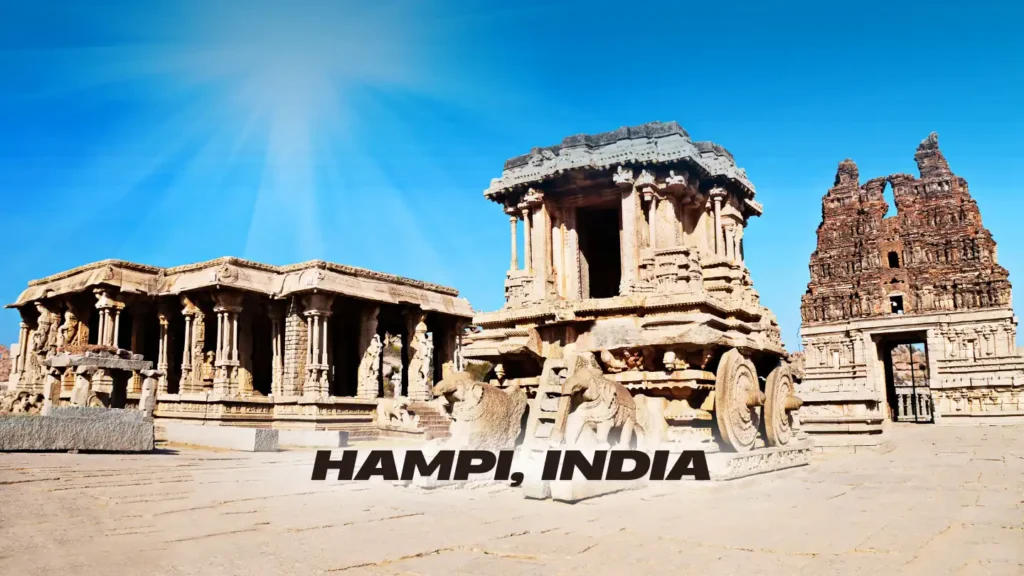Hampi, in northern Karnataka, is one of India’s most compelling heritage sites. Honored as a UNESCO World Heritage Site, it once served as the capital of the Vijayanagara Empire, one of South India’s mightiest kingdoms from the 14th to 16th centuries. Today, Hampi enchants visitors with its temple ruins, majestic palaces, ancient bazaars, and boulder-strewn terrain that appears almost otherworldly.
Here’s a detailed guide to ensure your trip to Hampi is unforgettable.
Table of Contents
Hampi, India Map
1. Visit the Iconic Temples of Hampi
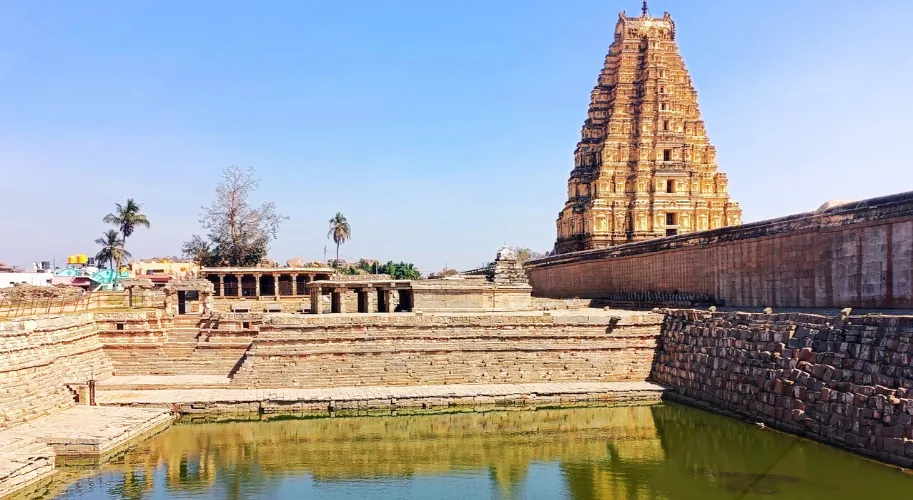
Temples are the soul of Hampi. Each one tells a story of devotion, architecture, and empire.
- Virupaksha Temple – Dedicated to Lord Shiva, this temple has been in continuous worship since the 7th century. The impressive 49-meter gopuram stands tall over Hampi, and the temple elephant, Lakshmi, offers blessings to visitors.
- Vittala Temple – Famous for the legendary stone chariot, now the symbol of Karnataka tourism, and the unique musical pillars that once produced different tones when struck. The temple complex is vast and beautifully carved.
- Achyutaraya Temple – Located near the base of Matanga Hill, this less-crowded temple offers stunning views and intricate carvings.
- Hemakuta Hill Temples – A group of small shrines scattered on rocky slopes, great for exploration and photography.
These temples showcase the rich fusion of faith, artistry, and history that defines Hampi.
2. Explore the Royal Enclosure and Monuments
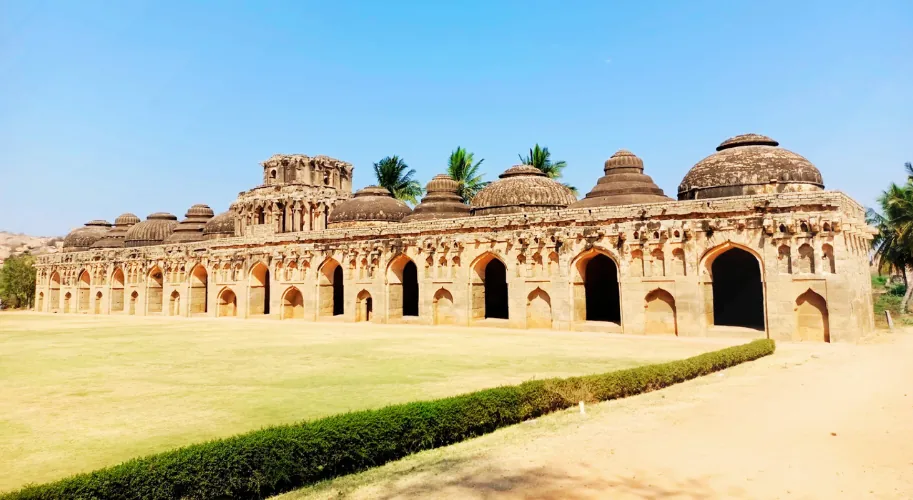
The Royal Enclosure was the heart of Vijayanagara power. Its enduring ruins echo the empire’s former grandeur.
- Mahanavami Dibba – A huge stone platform where the king viewed processions, festivals, and celebrations. Its carved walls display scenes of hunting, dancers, and elephants.
- Lotus Mahal – A delicate, lotus-shaped structure with a fusion of Hindu and Islamic architecture. It is believed to have been a socializing area for royal women.
- Elephant Stables – A row of domed chambers built for royal elephants. The scale and architecture reveal the importance of elephants to the kingdom.
- Queen’s Bath – An ornate bathing complex with arched corridors, believed to have been built for the royal women.
Walking around this area gives you a sense of how life thrived during the Vijayanagara dynasty.
3. Watch the Sunrise and Sunset from Scenic Hills
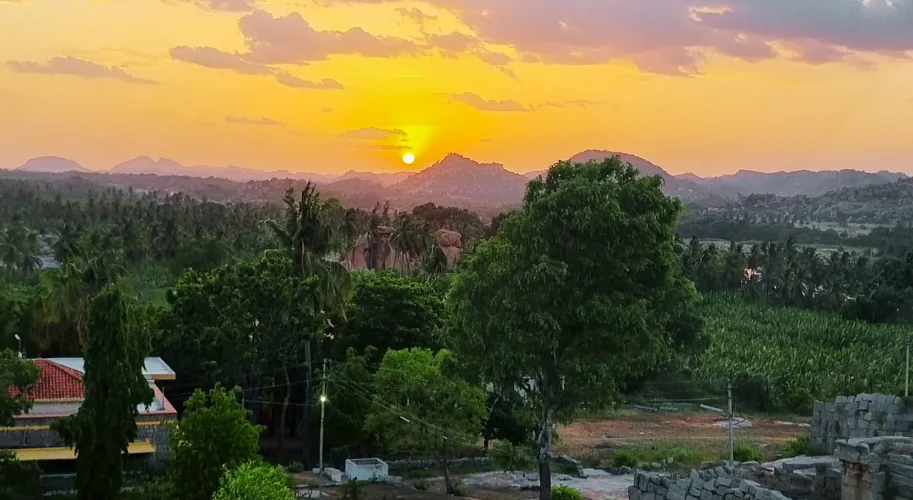
Hampi’s dramatic terrain of granite boulders provides some of the most stunning vistas in South India.
- Matanga Hill – The most popular sunrise spot. The climb is steep but rewarding, with panoramic views of temples, ruins, and paddy fields.
- Hemakuta Hill – A relatively easier climb, perfect for sunset. The golden light over Virupaksha Temple is magical.
- Anjanadri Hill – Believed to be the birthplace of Lord Hanuman. The climb involves about 575 steps, but the view of the Tungabhadra River winding through the rocky terrain is worth it.
If you love photography or quiet moments in nature, these hills are a must.
4. Take a Coracle Ride on the Tungabhadra River
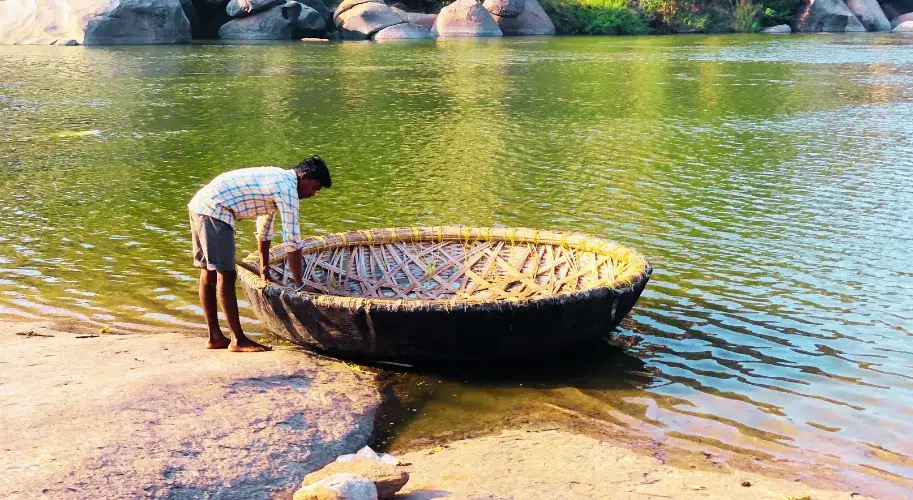
The Tungabhadra River is central to Hampi’s legacy. For a unique perspective, try a ride in a coracle – a traditional, round boat made of bamboo and leather. These journeys are tranquil and often reveal ruins, rugged boulders, and secluded shrines along the banks. It’s both soothing and adventurous.
5. Discover the Local Bazaars
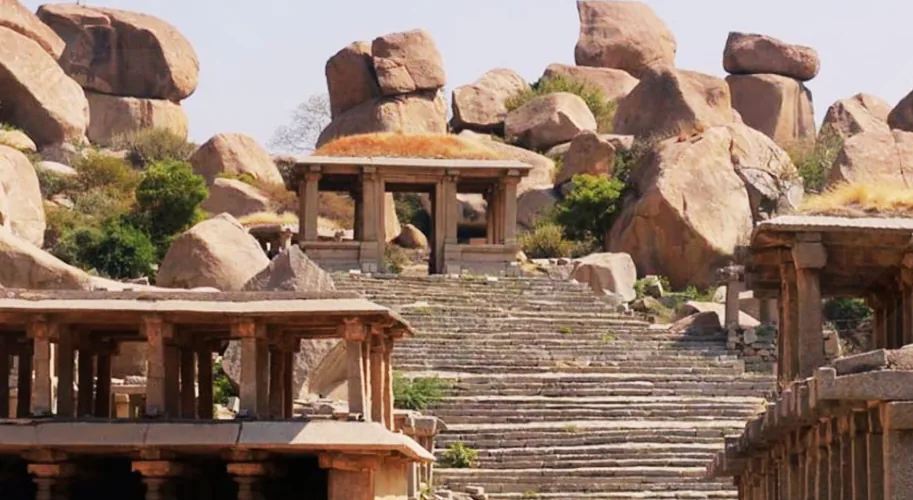
Hampi once thrived as a bustling trading center, where merchants dealt in gems, horses, and silks. Today, its bazaars still resonate with echoes of that era.
- Hampi Bazaar – Situated near Virupaksha Temple, it was once filled with jewel traders. Now, you’ll find cafés, small shops, and homestays.
- Sule Bazaar and Vittala Bazaar – Scattered ruins of market streets where traders once displayed precious goods.
Exploring these bazaars immerses you in the energetic commerce of the Vijayanagara period.
6. Experience Hampi Like a Local – Cycling and Walking Tours
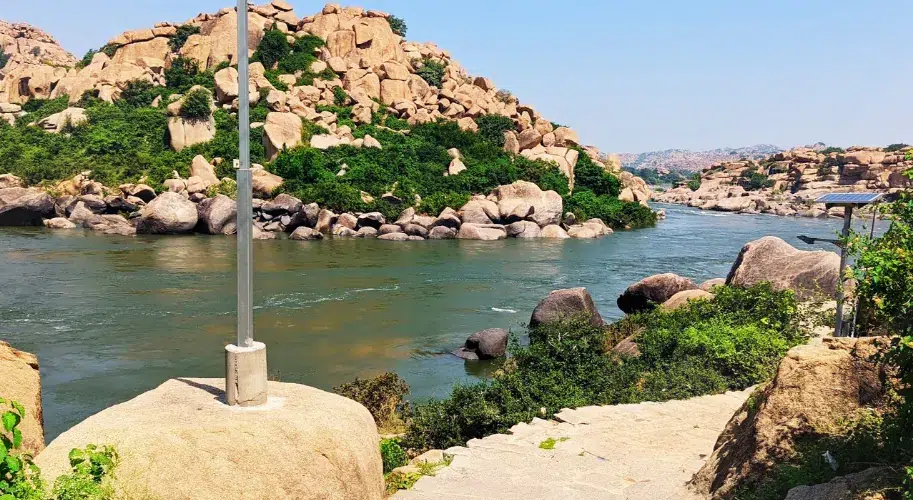
One of the best ways to explore Hampi is to do so slowly, either on foot, by bicycle, or with a rented scooter.
- Cycling through paddy fields, villages, and clusters of ruins makes each discovery feel like unveiling a hidden secret.
- Walking tours led by local guides often include fascinating stories about battles, myths, and daily life in the empire.
Exploring at your own pace helps you truly experience Hampi.
7. Cross to Hippie Island (Virupapur Gadde)
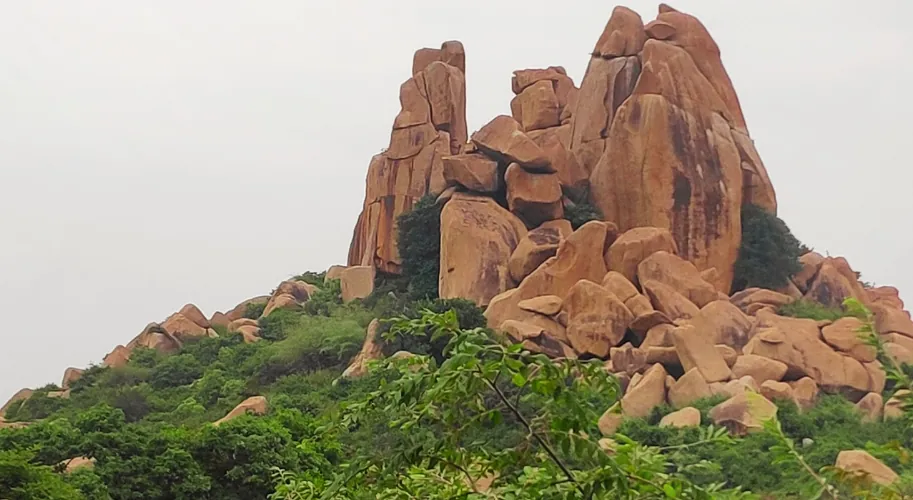
Virupapur Gadde, also known as Hippie Island, sits across the Tungabhadra River and attracts visitors with its laid-back atmosphere.
- Choose from a range of riverside guesthouses for your stay.
- Enjoy live music and bonfires at local cafés.
- Rent a moped to discover more secluded spots beyond the main ruins.
Although recent restrictions have closed some guesthouses, the island still retains its laid-back charm.
8. Visit the Archaeological Museum
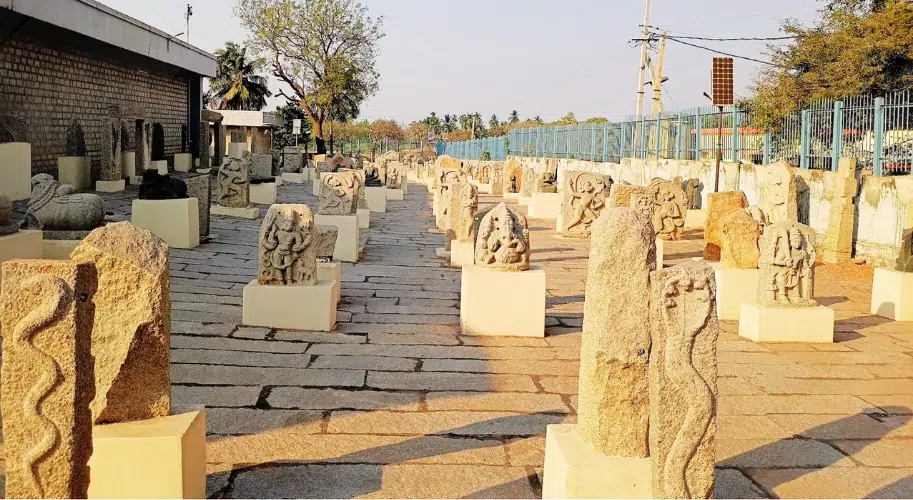
If you’re curious about the artifacts and sculptures excavated from Hampi, head to the Archaeological Museum in nearby Kamalapura. The museum displays idols, coins, and tools that give deeper insight into Hampi’s history and culture.
Practical Tips for Visiting Hampi
- Best time to visit: October to February. During these months, the weather is cooler and more comfortable for exploring Hampi’s sites and walking outdoors, making sightseeing a pleasant experience.
- Getting there: The nearest railway station is Hospet Junction, about 13 km from Hampi. The nearest airport is in Hubli, approximately 160 km away. You can reach Hampi from these points by taxi, auto-rickshaw, or bus.
- How long to stay: Plan to spend at least 3–4 days. This allows enough time to explore the main ruins, temples, and nearby villages without rushing.
- What to wear: Wear comfortable cotton clothes to cope with the heat and good walking shoes, as you’ll be covering long distances in the sun. Don’t forget a hat, sunglasses, and sunscreen for protection.
Final Thoughts – Things to Do in Hampi
Hampi is not just about stones and ruins – it’s about the stories they hold. From the towering Virupaksha Temple and the splendor of the Royal Enclosure to tranquil coracle rides and awe-inspiring sunsets, the things to do in Hampi go far beyond sightseeing. Here, history, spirituality, and natural beauty merge seamlessly, leaving every traveler with indelible memories.
More Read in India
Chinnasalem Tamil Nadu || Bhadra Wildlife Sanctuary Safari || Rajkot Tourist Places || Chikmagalur in 3 Days || Skydiving in Narnaul || Go Karting in Ahmedabad || Tourist Place In Begusarai || Gurudwara in Jaipur || Places to Visit in Murshidabad || Dooars Tourist Spot
FAQs
Q: How many days are enough to explore Hampi?
A: Ideally, 3–4 days are enough to cover major temples, ruins, and viewpoints at a relaxed pace.
Q: What is the best time to visit Hampi?
A: The best time is between October and February when the weather is pleasant for sightseeing.
Q: Is Hampi safe for solo travelers?
A: Yes, Hampi is generally safe for solo travelers. Just stay cautious at night and in less crowded areas.
Q: Can I visit Hampi in summer?
A: It’s possible, but summer temperatures can be very high. Carry water, wear light clothes, and plan morning or evening visits.
Q: How can I reach Hampi?
A: The nearest railway station is Hospet (13 km). The nearest airports are Hubli (160 km) and Bengaluru (350 km).

